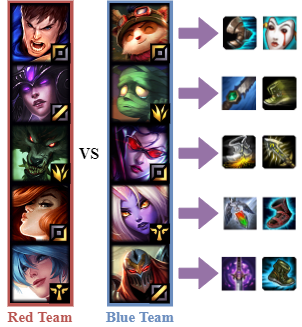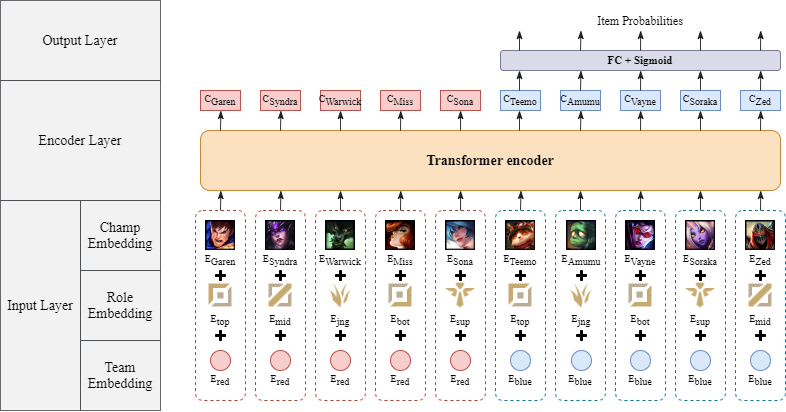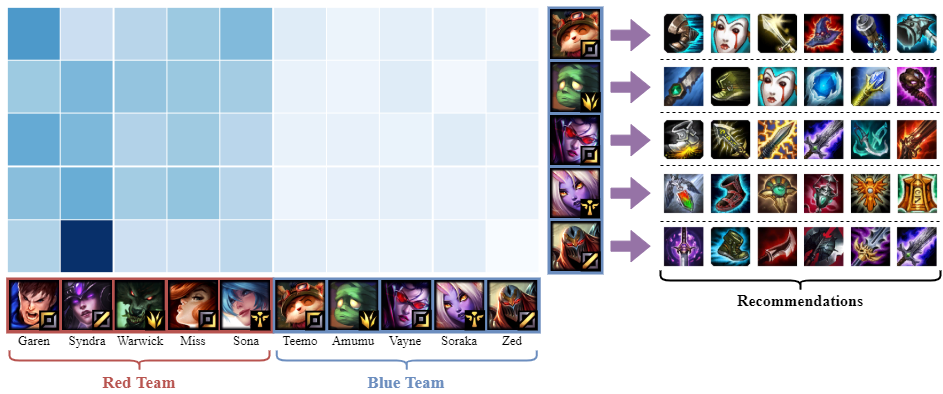Recommendation Systems for Item Recommendation in MOBA Games
Published:
The video game industry has adopted recommendation systems to boost users' interest with a focus on game sales. Other exciting applications within video games are those that help the player to make decisions that would maximize their gaming experience. In this blog, I am going to present to you a research focused on the second application that resulted in two papers presented in RecSys.
MOBA Games and Recommendation Problem
The annual report of Newzoo shows that global e-sports revenues and its audience will grow to $1.1 billion and 495 million people in 2020, respectively. MOBA is one of the most significant social gaming genres contributing to that growth. An example of this phenomenon is the League of Legends World Championship, which was the biggest tournament of 2019 with more than 105 million hours live on Twitch and YouTube. This type of games can rise up to 64 million active players per month worldwide, with over a billion monthly gaming hours, affirms Forbes.
League of Legends (LoL) has dominated the market since 2012 and is considered one of the most popular electronic games. The game consists of two teams (red and blue) of five players each, that compete to be the first to destroy the enemy base. Each player controls one character (champion) that interacts with the rest through combats, which are carried out in a particular arena.
The pace of the game is encouraged by an in-game currency reward system, which is used to buy items that increase the statistics and performance of the champion. This is one of the main ways for the players to increase their attack and defense power, thereby increasing their contribution to winning the game.
This game presents at least two recommendation problems: champion (Chen et al., 2018) and item recommendation (Looi et al., 2018), because there are more than 140 characters and around 240 items. Both the choice of champions and the items pose the challenge of the number of possible combinations, which users face making decisions based on experience. In this work, we focused on the latter.

Data Mining for Item Recommendation in MOBA Games
Framework
In order to tackle this task, we proposed a framework based on classical data mining methodology, including slight changes to use it for the recommendation task. This methodology allows generating recommendations using knowledge learned from the actions carried out by the users in previous matches.

The first step consists on preprocessing the dataset. We used a dataset provided by Kaggle. Because the purpose is a recommendation for a specifc champion, we decided to reorganize the data. The final dataset has transactional structure, where each instance includes the identifers of a selected champion during a match, the items used, and the enemies involved.
The second step is to apply techniques of data mining, both descriptive and predictive. On the one hand, we implement a recommender system based on association rules mining. We use Apriori and Eclat algorithms for this purpose. On the other hand, for the recommender systems based on a classifier, we use Decision Trees, Logistic Regression, and Artificial Neural Network.
Finally, in order to generate the itemset recommendation for the user, we use a sort function over the output of the recommender systems based on its probabilities.
Results
As we expected ANN model outperforms the other approaches, achieving F1 of 56%, and MAP of 78%, while the worst was Apriori approach reaching F1 of 48%, and MAP of 58%. Also, ANN obtained the best MRR, which might indicate that this model recommends the first best situational-item.
| Metric | Apriori | Eclat | D Tree | Logit | ANN |
|---|---|---|---|---|---|
| F1@1 | 0.18 | 0.18 | 0.21 | 0.27 | 0.32 |
| MAP@1 | 0.43 | 0.44 | 0.52 | 0.67 | 0.77 |
| F1@6 | 0.48 | 0.48 | 0.37 | 0.47 | 0.56 |
| MAP@6 | 0.58 | 0.59 | 0.64 | 0.71 | 0.78 |
Limitations
This first work proposes a novel use of recommendation systems for the recommendation of items in MOBA games. However, there are some limitations to address:
- Models do not take advantage of relevant information about the context of the matches. For example, it may be useful to use information from roles or teams.
- In the context of MOBA games, an explanation of why a recommendation is given would be desirable.
If you want to explore the systems, you could find them here: https://github.com/vgaraujov/RecSysLoL
Interpretable Contextual Team-aware Item Recommendation: Application in Multiplayer Online Battle Arena Games
As a second part of this project, we focus on how to exploit the additional information that appears in a match. Using the same framework and opting for the predictive approach, we decided to explore more advanced encoders. Motivated by the success of the Transformer architecture in encoding different types of data, we decided to use it to obtain richer representations of the characters in a match.
Transformer-based Architecture
The figure below shows the Transformer for Team-aware Item Recommendation architecture (TTIR). This model is made up of three major parts: the input representation layer, the encoder layer, and the output layer for recommendation.

The input representation layer takes inspiration from the BERT model. We represent the information of a game using three types of embeddings: champion, role, and team. The sum of them is the actual input to the encoder layer.
The encoder layer is a Transformer model, which returns the contextual embeddings of the match. The advantage of using this architecture is that it is possible to obtain contextual representations as well as attention vectors that could be used to analyze the predictions.
The recommendation layer is a fully connected layer in charge of predicting the most probable itemset for each champion of a team.
Results
Our model achieves significant improvements compared to the baselines. The difference in performance between TTIR and other models is due to the ability of the Transformer to include relevant contextual information of the match into the representation of each champion.
| Metric | D Tree | Logit | ANN | CNN | TTIR |
|---|---|---|---|---|---|
| F1@1 | 0.21 | 0.27 | 0.32 | 0.33 | 0.34 |
| MAP@1 | 0.52 | 0.67 | 0.77 | 0.79 | 0.80 |
| F1@6 | 0.37 | 0.47 | 0.56 | 0.58 | 0.60 |
| MAP@6 | 0.64 | 0.71 | 0.78 | 0.79 | 0.81 |
We also performed an ablation analysis showing that the number of attention heads is more important than the number of layers for this application. In addition, it is shown that including enemy and role information (context information) contributes to better performance in the recommendations.
Attention as Explanation
Transformer attention weights commonly show what the model focused on to make a prediction. In the case of this recommendation system, we postulate that these values could be used as an explanation of the recommendation for the user.

The figure above shows the characters involved in the match on the x-axis, and the characters to which items will be recommended on the y-axis. The heat map represents the influence that the champions had on a specific one to generate the recommendation. For example, Zed is heavily influenced by his opponent Syndra, and that explains why the Maw of Malmortius item were recommended.
User Survey
In order to get insights from LoL players about the relevance of our recommendations and the visualization, we conducted a preliminary survey. The survey consisted of showing subjects four cases similar to the one displayed in Figure abouve. Subjects were told that they belonged to the Blue team and that they were facing the Red team. Then they had to judge the quality of the recommendations for the Blue team and the usefulness of the explanations provided by the heatmap.
As a result, we observe that people have a fairly positive perception of the relevance of the recommendation, but this perception seems to be more favorable for less experienced users.
Final Remarks
Transformer architecture allow us to model the complex contextual relationships present in the matches, and its attention weights serve to generate explanations for the suggested items. Our initial analysis indicates that expert users require more details for understanding and following the recommendations, while less experienced users find them coherent and useful.
For future work, we consider providing more details in the explanations of our recommendations, such as the item statistics. Also sequential recommendation of items that could be used during an online game.
If you want to explore the TTIR model, you could find them here: https://github.com/ojedaf/IC-TIR-Lol
Citation
If you find this work useful for your research, please consider citing our papers:
@inproceedings{10.1145/3298689.3346986,
author = {Araujo, Vladimir and Rios, Felipe and Parra, Denis},
title = {Data Mining for Item Recommendation in MOBA Games},
year = {2019},
isbn = {9781450362436},
publisher = {Association for Computing Machinery},
address = {New York, NY, USA},
url = {https://doi.org/10.1145/3298689.3346986},
doi = {10.1145/3298689.3346986},
booktitle = {Proceedings of the 13th ACM Conference on Recommender Systems},
pages = {393–397},
numpages = {5},
keywords = {item recommendation, MOBA games, data mining},
location = {Copenhagen, Denmark},
series = {RecSys ’19}
}
@inproceedings{10.1145/3383313.3412211,
author = {Villa, Andr\'{e}s and Araujo, Vladimir and Cattan, Francisca and Parra, Denis},
title = {Interpretable Contextual Team-Aware Item Recommendation: Application in Multiplayer Online Battle Arena Games},
year = {2020},
isbn = {9781450375832},
publisher = {Association for Computing Machinery},
address = {New York, NY, USA},
url = {https://doi.org/10.1145/3383313.3412211},
doi = {10.1145/3383313.3412211},
booktitle = {Fourteenth ACM Conference on Recommender Systems},
pages = {503–508},
numpages = {6},
keywords = {Item Recommendation, Deep Learning, MOBA Games},
location = {Virtual Event, Brazil},
series = {RecSys '20}
}
